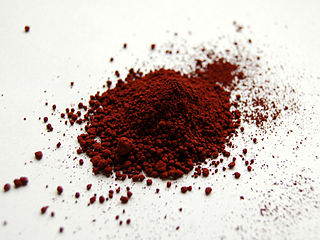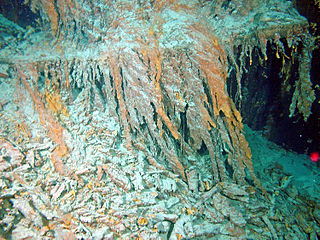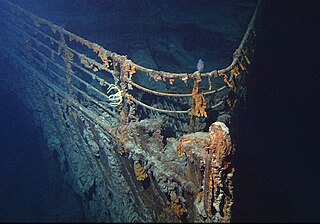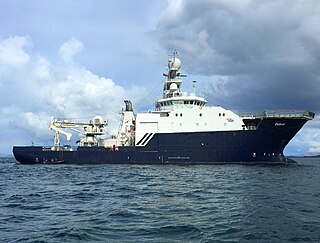
Rust is an iron oxide, a usually reddish-brown oxide formed by the reaction of iron and oxygen in the catalytic presence of water or air moisture. Rust consists of hydrous iron(III) oxides (Fe2O3·nH2O) and iron(III) oxide-hydroxide (FeO(OH), Fe(OH)3), and is typically associated with the corrosion of refined iron.
An organic acid is an organic compound with acidic properties. The most common organic acids are the carboxylic acids, whose acidity is associated with their carboxyl group –COOH. Sulfonic acids, containing the group –SO2OH, are relatively stronger acids. Alcohols, with –OH, can act as acids but they are usually very weak. The relative stability of the conjugate base of the acid determines its acidity. Other groups can also confer acidity, usually weakly: the thiol group –SH, the enol group, and the phenol group. In biological systems, organic compounds containing these groups are generally referred to as organic acids.

In chemistry, iron (III) refers to the element iron in its +3 oxidation state. In ionic compounds (salts), such an atom may occur as a separate cation (positive ion) denoted by Fe3+.

Corrosion is a natural process that converts a refined metal into a more chemically stable oxide. It is the gradual deterioration of materials by chemical or electrochemical reaction with their environment. Corrosion engineering is the field dedicated to controlling and preventing corrosion.
In physical chemistry and engineering, passivation is coating a material so that it becomes "passive", that is, less readily affected or corroded by the environment. Passivation involves creation of an outer layer of shield material that is applied as a microcoating, created by chemical reaction with the base material, or allowed to build by spontaneous oxidation in the air. As a technique, passivation is the use of a light coat of a protective material, such as metal oxide, to create a shield against corrosion. Passivation of silicon is used during fabrication of microelectronic devices. Undesired passivation of electrodes, called "fouling", increases the circuit resistance so it interferes with some electrochemical applications such as electrocoagulation for wastewater treatment, amperometric chemical sensing, and electrochemical synthesis.

Iron(III) oxide or ferric oxide is the inorganic compound with the formula Fe2O3. It is one of the three main oxides of iron, the other two being iron(II) oxide (FeO), which is rare; and iron(II,III) oxide (Fe3O4), which also occurs naturally as the mineral magnetite. As the mineral known as hematite, Fe2O3 is the main source of iron for the steel industry. Fe2O3 is readily attacked by acids. Iron(III) oxide is often called rust, since rust shares several properties and has a similar composition; however, in chemistry, rust is considered an ill-defined material, described as hydrous ferric oxide.

A shipwreck is the wreckage of a ship that is located either beached on land or sunken to the bottom of a body of water. Shipwrecking may be intentional or unintentional. There were approximately three million shipwrecks worldwide as of January 1999, according to Angela Croome, a science writer and author who specialized in the history of underwater archaeology.

A remotely operated underwater vehicle (ROUV) or remotely operated vehicle (ROV) is a free-swimming submersible craft used to perform underwater observation, inspection and physical tasks such as valve operations, hydraulic functions and other general tasks within the subsea oil and gas industry, military, scientific and other applications. ROVs can also carry tooling packages for undertaking specific tasks such as pull-in and connection of flexible flowlines and umbilicals, and component replacement.

Sulfate-reducing microorganisms (SRM) or sulfate-reducing prokaryotes (SRP) are a group composed of sulfate-reducing bacteria (SRB) and sulfate-reducing archaea (SRA), both of which can perform anaerobic respiration utilizing sulfate (SO2−
4) as terminal electron acceptor, reducing it to hydrogen sulfide (H2S). Therefore, these sulfidogenic microorganisms "breathe" sulfate rather than molecular oxygen (O2), which is the terminal electron acceptor reduced to water (H2O) in aerobic respiration.

Ectoine is a natural compound found in several species of bacteria. It is a compatible solute which serves as a protective substance by acting as an osmolyte and thus helps organisms survive extreme osmotic stress. Ectoine is found in high concentrations in halophilic microorganisms and confers resistance towards salt and temperature stress. Ectoine was first identified in the microorganism Ectothiorhodospira halochloris, but has since been found in a wide range of Gram-negative and Gram-positive bacteria. Other species of bacteria in which ectoine was found include:
Microbial corrosion, also called microbiologically influenced corrosion (MIC), microbially induced corrosion (MIC), or biocorrosion, is when microbes affect the electrochemical environment of the surface they are on. This usually involves building a biofilm, which can lead to either an increase in corrosion of the surface or, in a process called microbial corrosion inhibition, protect the surface from corrosion. Microbial corrosion is worth discussing because it causes trillions of dollars in damage around the globe annually and because every surface that is in some way exposed to the environment is also exposed to microbially induced corrosion. Microbes can corrode in two ways. They can produce byproducts from their cellular processes that corrode metals, or they can keep normal corrosion inhibitors from functioning, leaving surfaces open to attack from other environmental factors.

The archaeology of shipwrecks is the field of archaeology specialized most commonly in the study and exploration of shipwrecks. Its techniques combine those of archaeology with those of diving to become Underwater archaeology. However, shipwrecks are discovered on what have become terrestrial sites.
Phosphate conversion coating is a chemical treatment applied to steel parts that creates a thin adhering layer of iron, zinc, or manganese phosphates, to achieve corrosion resistance, lubrication, or as a foundation for subsequent coatings or painting. It is one of the most common types of conversion coating. The process is also called phosphate coating, phosphatization, phosphatizing, or phosphating. It is also known by the trade name Parkerizing, especially when applied to firearms and other military equipment.

Green rust is a generic name for various green crystalline chemical compounds containing iron(II) and iron(III) cations, the hydroxide (HO−
) anion, and another anion such as carbonate (CO2−
3), chloride (Cl−
), or sulfate (SO2−
4), in a layered double hydroxide structure. The most studied varieties are

Halomonas titanicae is a gram-negative, halophilic species of bacteria which was isolated in 2010 from rusticles recovered from the wreck of the RMS Titanic. It has been estimated by Henrietta Mann, one of the researchers that first isolated it, that the action of microbes like Halomonas titanicae may bring about the total deterioration of the Titanic by 2030. While the bacteria have been identified as a potential danger to oil rigs and other man-made objects in the deep sea, they also have the potential to be used in bioremediation to accelerate the decomposition of shipwrecks littering the ocean floor.

The wreck of the Titanic lies at a depth of about 12,500 feet, about 370 nautical miles south-southeast off the coast of Newfoundland. It lies in two main pieces about 2,000 feet (600 m) apart. The bow is still recognisable with many preserved interiors, despite deterioration and damage sustained hitting the sea floor. In contrast, the stern is heavily damaged. A debris field around the wreck contains hundreds of thousands of items spilled from the ship as she sank. The bodies of the passengers and crew would also be distributed across the sea bed, but have since been consumed by other organisms.

Galvanic corrosion is an electrochemical process in which one metal corrodes preferentially when it is in electrical contact with another, in the presence of an electrolyte. A similar galvanic reaction is exploited in primary cells to generate a useful electrical voltage to power portable devices. This phenomenon is named after Italian physician Luigi Galvani (1737–1798).

The conservation and restoration of shipwreck artifacts is the process of caring for cultural heritage that has been part of a shipwreck. Oftentimes these cultural artifacts have been underwater for a great length of time. Without conservation, most artifacts would perish and important historical data would be lost. In archaeological terms, it is usually the responsibility of an archaeologist and conservator to ensure that material recovered from a shipwreck is properly cared for. The conservation phase is often time-consuming and expensive, which is one of the most important considerations when planning and implementing any action involving the recovery of artifacts from a shipwreck.

The conservation-restoration of the H.L. Hunley is currently being undertaken by the Warren Lasch Conservation Center; they hope to have the Hunley project completed by 2020. Since the Hunley was located in 1970 by Dr. E. Lee Spence and recovered from the ocean in 2000, a team of conservators from the Lasch Conservation Center has been working to restore the Hunley.

RV Petrel, or R/V Petrel, is a 76.45 m (250.8 ft) research vessel owned by the United States Navy and once owned by Microsoft co-founder Paul Allen. The ship is named after the petrel, a sea bird. The ship was completed by Brattvaag Skipsverft, Norway in 2003 as the deepwater offshore inspection vessel Seaway Petrel for service with Stolt Offshore. It was later renamed Acergy Petrel, then Seven Petrel with Subsea 7.
















